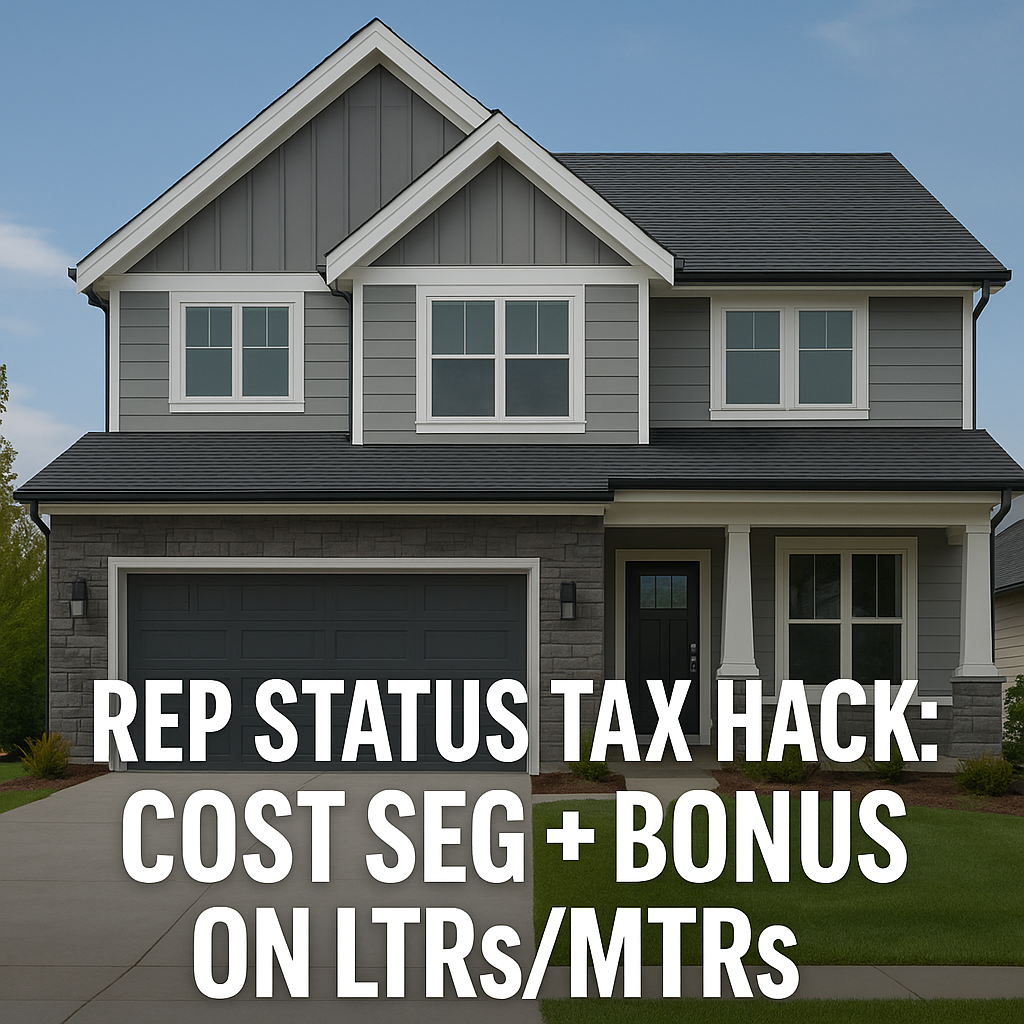Cost Segregation and Bonus Depreciation with REP Status: Can You Use Them on Mid- and Long-Term Rentals?

At a Glance
- Yes — with Real Estate Professional (REP) status, you can apply cost segregation and bonus depreciation to mid- and long-term rentals (MTRs/LTRs).
- Without REP, depreciation losses from these rentals are passive and can’t offset W2 income.
- REP status reclassifies your rental activity as non-passive, letting losses reduce active income.
- Proper documentation of material participation is critical — the IRS scrutinizes REP claims heavily.
- Bonus depreciation + REP status = a powerful tax shield against high W2 or business income.
Understanding the REP Advantage
When you or your spouse qualify as a Real Estate Professional (REP), the IRS allows you to treat your rental activities as non-passive.
This means depreciation deductions (including cost segregation + bonus depreciation) don’t just offset rental income — they can offset your W2 wages, commissions, or business income.
Without REP status, only short-term rentals (STRs) qualify for this special treatment under the STR Loophole. Mid-term and long-term rentals stay locked in the passive bucket.
What Is Cost Segregation?
Cost segregation is a tax strategy that breaks down a property into components with shorter depreciable lives:
- 5-year property – appliances, carpet, furniture.
- 7-year property – fixtures, specialty equipment.
- 15-year property – land improvements like landscaping, driveways, fencing.
Normally, residential rental property depreciates on a 27.5-year schedule. With cost segregation, much of that depreciation gets pulled forward.
Bonus Depreciation: The Game Changer
Thanks to the Opportunity to Build and Boost Bill (OBBB), 100% bonus depreciation is back. That means you can fully expense eligible 5-, 7-, and 15-year assets in Year 1.
- Example: Buy a $1M long-term rental.
- Cost seg identifies $250K in short-life assets.
- With REP status, that $250K flows directly against your W2 income.
- At a 37% tax bracket, you just saved $92,500 in federal taxes.
REP vs. STR Loophole
Here’s how REP compares to the STR loophole:
| Scenario | STR Loophole | REP Status (LTR/MTR) |
|---|---|---|
| Can offset W2 income? | ✅ Yes (no REP required if STR rules met) | ✅ Yes, but only with REP status |
| Material participation hours | 100+ hrs per property OR more than any other person | 750 hrs annually + >50% of total working time |
| Outsourcing allowed? | Limited – must prove material participation | Limited – heavy outsourcing weakens REP claim |
| Works for LTRs/MTRs? | ❌ No | ✅ Yes |
IRS Scrutiny and Documentation
REP status is one of the most audited sections of the tax code. To protect yourself:
- Keep daily or weekly time logs.
- Document material participation — meetings, calls, tenant interactions, repairs.
- Consider tools like REPSLog or custom spreadsheets.
- Work with a CPA who specializes in REP and STR tax planning.
At ViaSTR, we recommend WCG Inc. (wcginc.com), a firm we’ve personally worked with. They specialize in STR tax strategy, REP status planning, and make the complex rules easy to navigate.
Example Walkthrough
- You earn $500K W2.
- Buy a $1.2M long-term rental.
- Cost segregation generates $300K bonus depreciation.
- With REP status, that $300K applies to your W2 income.
- Federal tax savings at 37% ≈ $111K.
That’s how high earners use REP status to transform long-term rentals into powerful tax shields.
Key Takeaways
- Yes, you can use cost segregation and bonus depreciation on mid- and long-term rentals if you qualify as a Real Estate Professional.
- Without REP, those losses are stuck as passive and can’t offset W2 income.
- The STR loophole is simpler, but REP expands your tax strategy across all rental types.
- Documentation and CPA support are non-negotiable.
See Also
- The STR Loophole Explained: Offset W2 Income Without REP
- Passing STR Wealth to Your Kids, Tax-Free
- I Just Got a Rental, What Do I Do Next?



